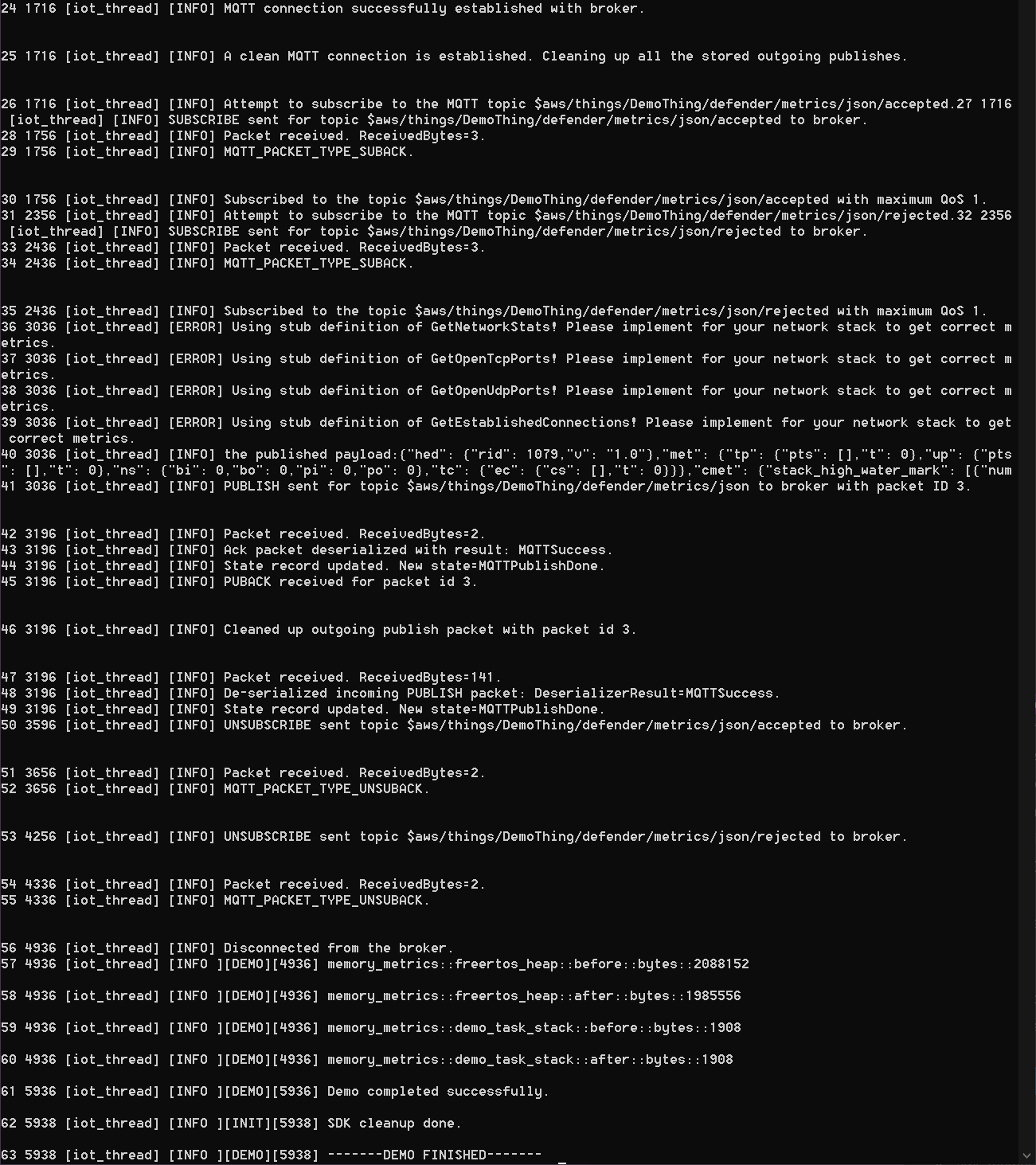Amazon IoT Device Defender demo
Important
This demo is hosted on the Amazon-FreeRTOS repository which is deprecated. We recommend that you start here when you create a new project. If you already have an existing FreeRTOS project based on the now deprecated Amazon-FreeRTOS repository, see the Amazon-FreeRTOS Github Repository Migration Guide.
Introduction
This demo shows you how to use the Amazon IoT Device Defender library to connect to Amazon IoT Device Defender. The demo uses the coreMQTT library to establish an MQTT connection over TLS (mutual authentication) to the Amazon IoT MQTT Broker and the coreJSON library to validate and parse responses received from the Amazon IoT Device Defender service. The demo shows you how to construct a JSON formatted report using metrics collected from the device, and how to submit the constructed report to the Amazon IoT Device Defender service. The demo also shows how to register a callback function with the coreMQTT library to handle the responses from the Amazon IoT Device Defender service to confirm whether a sent report was accepted or rejected.
Note
To set up and run the FreeRTOS demos, follow the steps in Get Started with FreeRTOS.
Functionality
This demo creates a single application task that demonstrates how to collect metrics, construct a device defender report in JSON format, and submit it to the Amazon IoT Device Defender service through a secure MQTT connection to the Amazon IoT MQTT Broker. The demo includes the standard networking metrics as well as custom metrics. For custom metrics, the demo includes:
-
A metric named "
task_numbers" which is a list of FreeRTOS task IDs. The type of this metric is "list of numbers". -
A metric named "
stack_high_water_mark" which is the stack high watermark for the demo application task. The type of this metric is "number".
How we collect networking metrics depends on the TCP/IP stack in use. For FreeRTOS+TCP and supported lwIP
configurations, we provide metrics collection implementations that collect real metrics from the device and
submit them in the Amazon IoT Device Defender report. You can find the implementations for
FreeRTOS+TCP
For boards using any other TCP/IP stack, we provide stub definitions of the metrics collection functions that
return zeros for all networking metrics. Implement the functions in
freertos/demos/device_defender_for_aws/metrics_collector/stub/metrics_collector.c
For ESP32, the default lwIP configuration does not use core locking and therefore the demo will use stubbed
metrics. If you want to use the reference lwIP metrics collection implementation, define the following macros in
lwiopts.h:
#define LINK_SPEED_OF_YOUR_NETIF_IN_BPS 0 #define LWIP_TCPIP_CORE_LOCKING 1 #define LWIP_STATS 1 #define MIB2_STATS 1
The following is an example output when you run the demo.

If your board isn't using FreeRTOS+TCP or a supported lwIP configuration, the output will look like the following.

The source code of the demo is in your download in
freertos/demos/device_defender_for_aws/
Subscribing to Amazon IoT Device Defender topics
The
subscribeToDefenderTopicsDEFENDER_API_JSON_ACCEPTED to construct the topic string on which responses for accepted device
defender reports are received. It uses the macro DEFENDER_API_JSON_REJECTED to construct the topic
string on which responses for rejected device defender reports will be received.
Collecting device metrics
The
collectDeviceMetricsmetrics_collector.h. The metrics collected are the number of bytes and packets sent
and received, the open TCP ports, the open UDP ports, and the established TCP connections.
Generating the Amazon IoT Device Defender report
The
generateDeviceMetricsReportreport_builder.h. That function takes the networking metrics and a buffer, creates a JSON
document in the format as expected by Amazon IoT Device Defender and writes it to the provided buffer. The format of the JSON
document expected by Amazon IoT Device Defender is specified in Device-side metrics in the
Amazon IoT Developer Guide.
Publishing the Amazon IoT Device Defender report
The Amazon IoT Device Defender report is published on the MQTT topic for publishing JSON Amazon IoT Device Defender reports. The report is
constructed using the macro DEFENDER_API_JSON_PUBLISH, as shown in this
code snippet
Callback for handling responses
The
publishCallbackDefender_MatchTopic API from the Amazon IoT Device Defender library to check if the incoming MQTT message is from
the Amazon IoT Device Defender service. If the message is from the Amazon IoT Device Defender service, it parses the received JSON response and
extracts the report ID in the response. The report ID is then verified to be the same as the one sent in the
report.